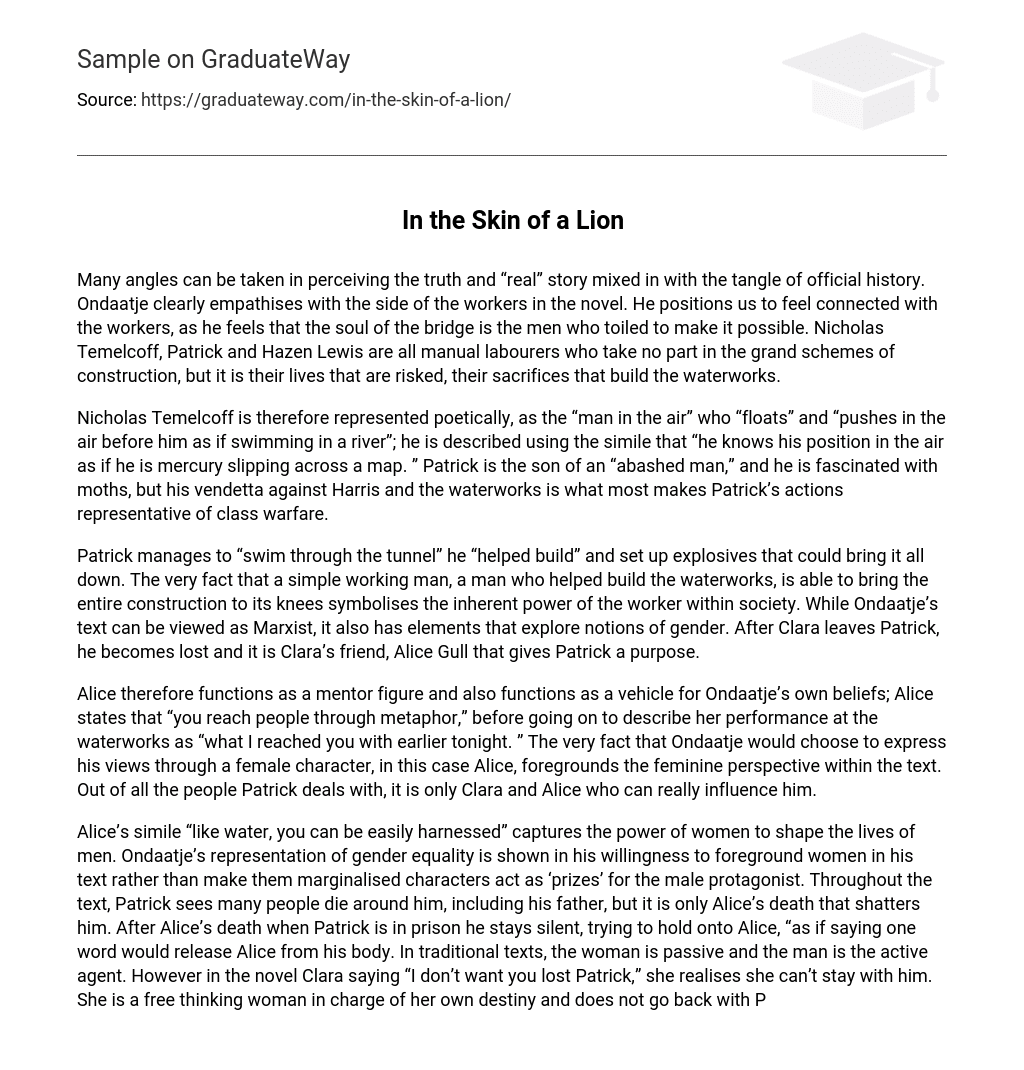Many angles can be taken in perceiving the truth and “real” story mixed in with the tangle of official history. Ondaatje clearly empathises with the side of the workers in the novel. He positions us to feel connected with the workers, as he feels that the soul of the bridge is the men who toiled to make it possible. Nicholas Temelcoff, Patrick and Hazen Lewis are all manual labourers who take no part in the grand schemes of construction, but it is their lives that are risked, their sacrifices that build the waterworks.
Nicholas Temelcoff is therefore represented poetically, as the “man in the air” who “floats” and “pushes in the air before him as if swimming in a river”; he is described using the simile that “he knows his position in the air as if he is mercury slipping across a map. ” Patrick is the son of an “abashed man,” and he is fascinated with moths, but his vendetta against Harris and the waterworks is what most makes Patrick’s actions representative of class warfare.
Patrick manages to “swim through the tunnel” he “helped build” and set up explosives that could bring it all down. The very fact that a simple working man, a man who helped build the waterworks, is able to bring the entire construction to its knees symbolises the inherent power of the worker within society. While Ondaatje’s text can be viewed as Marxist, it also has elements that explore notions of gender. After Clara leaves Patrick, he becomes lost and it is Clara’s friend, Alice Gull that gives Patrick a purpose.
Alice therefore functions as a mentor figure and also functions as a vehicle for Ondaatje’s own beliefs; Alice states that “you reach people through metaphor,” before going on to describe her performance at the waterworks as “what I reached you with earlier tonight. ” The very fact that Ondaatje would choose to express his views through a female character, in this case Alice, foregrounds the feminine perspective within the text. Out of all the people Patrick deals with, it is only Clara and Alice who can really influence him.
Alice’s simile “like water, you can be easily harnessed” captures the power of women to shape the lives of men. Ondaatje’s representation of gender equality is shown in his willingness to foreground women in his text rather than make them marginalised characters act as ‘prizes’ for the male protagonist. Throughout the text, Patrick sees many people die around him, including his father, but it is only Alice’s death that shatters him. After Alice’s death when Patrick is in prison he stays silent, trying to hold onto Alice, “as if saying one word would release Alice from his body. In traditional texts, the woman is passive and the man is the active agent. However in the novel Clara saying “I don’t want you lost Patrick,” she realises she can’t stay with him. She is a free thinking woman in charge of her own destiny and does not go back with Patrick. Following Alice’s death and Patrick’s scheme against the waterworks, it is another female that gives him a reason to carry on. Patrick takes on the role of the father to Alice’s daughter Hana. Hana gives Patrick a reason to carry on despite having lost the woman he wished to grow old with.
From a personal perspective, Ondaatje’s novel values the contributions made by every member of society, not just exclusively one group. This reading values contributions made by individuals from society towards an overall cause. The story itself revolves around the construction of a bridge and waterworks, a project overseen by the commissioner of the public works, Rowland Harris. Harris is the man whom ‘official’ history remembers as the brilliant individual who ensured the construction was a success.
The project would not have worked unless there had been a commissioner to oversee the project and workers to build it. For all Harris’ faults, he had an incredible devotion to the project and its success. When the nun, seemingly falls off the unfinished bridge to her death, Harris’ reaction is not of fear for the nun, but sorrow for the bridge itself. Harris describes the bridge as “his first child” and his pity for it is shown as he realises that “it had already become a murderer. ” Ondaatje has used personification in this example to show how Harris views the bridge as a living child.
Harris himself even realises the contributions made by the workers, as he forgives Patrick for his attempted backlash against the waterworks. Patrick accuses Harris of excess when he states that Harris’ “goddamn herringbone tiles cost more than half our salaries put together. ” Rather than deny this, Harris states that “yes, that’s true,” but argues that it is necessary for the waterworks to live on. This conversation between Harris and Patrick is a good summation of the efforts of both the workers and the commissioner during the project.
Harris’ cliche, that he fought “tooth and nail” to get the materials needed, is contradicted by Patrick’s rebuke, “as much of the fabric as the aldermen and the millionaires. ” This is where the two paths, that of the workers, and that of the commissioner meet; Harris realises that Patrick and the other workers fought hard but are “among the dwarfs of enterprise who never get accepted or acknowledged. ” Ultimately the novel explores the multi-faceted natured of truth and the contributions made by a multitude of individuals rather than simply allocating glory to the upper echelons of society.





